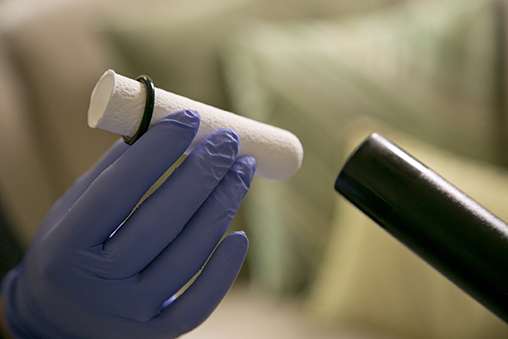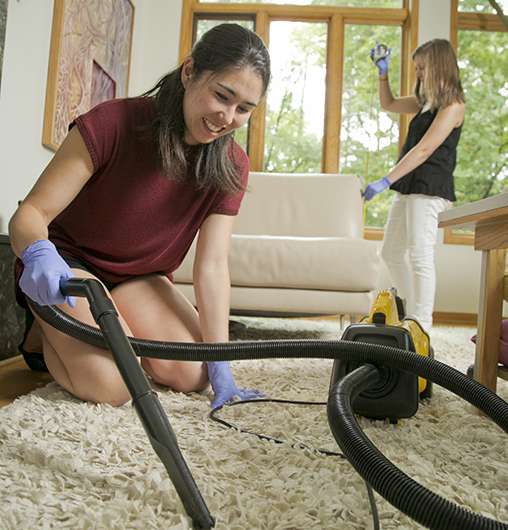Are flame retardant chemicals fueling thyroid cancer?

Surgeon Julie Ann Sosa, MD, professor of advanced oncologic and GI surgery, is an international authority on thyroid cancer, and right about now her expertise is in great demand. Thyroid cancer is the fastest-increasing cancer in the United States in both men and women. In just three years, the endocrine surgery program that Sosa runs at Duke has grown from one surgeon to four.
But when Sosa started talking to environmental chemist Heather Stapleton, PhD, she started thinking about how to put herself out of business.
Stapleton, the Dan and Bunny Gabel Associate Professor of Environmental Ethics and Sustainable Environmental Management, runs the go-to lab in the nation for identifying flame-retardant chemicals lurking in furniture, TVs, and other products. Because chemical companies are allowed to keep their formulations secret, even furniture manufacturers often don't know which chemicals are in their products or how harmful they may be. Many flame retardants can slowly leach out of products and end up in the dust in your house. In almost all homes, Stapleton has detected traces of several chemicals that were banned years ago.
When Sosa met Stapleton through a colleague, she was fascinated to learn all of this. She was especially interested in Stapleton's studies in animals showing that some flame retardants alter thyroid function, and that because of the shape of the molecules, the chemicals may be able to throw our own hormones out of whack.
Could the growing rate of thyroid cancer be caused in part by exposure to these chemicals that are found in most of our homes?
Many scientists have thought about this question, but Sosa and Stapleton have the tools, knowledge, and patients they need to actually explore it in real people. They're doing just that in a pilot study, funded by Duke Cancer Institute's pilot grant program in Cancer and the Environment.

Thyroid cancer incidence in the United States has increased more than 270 percent in the last 20 years. Rates are also increasing around the world. "It's a pandemic," Sosa says. Some have argued that rates aren't really rising that much, but rather that more tumors are being diagnosed because of increased use of imaging, which detects even the smallest of tumors. "That isn't the whole story, because it's not just the smallest cancers that are increasing in incidence," Sosa says. "And the increase is also being seen in developing countries; they're not doing more CT scans or more MRIs. There must be something else that could explain this."
An environmental cause makes sense, especially since certain types of chemicals, known as brominated flame retardants, can alter thyroid function. "The chemical structure of one class of flame retardants is very similar to thyroid hormones that circulate in our body," Stapleton says. "There are a number of different pathways by which these chemicals can interfere with thyroid hormone regulation. And we know that their use, and our exposure to these chemicals, has increased tremendously over the past several decades."
Participants in Stapleton's and Sosa's study include Duke patients with thyroid cancer and people of the same age and sex who don't have thyroid cancer. They provide blood and urine samples, and they allow Stapleton's team to visit their homes to collect dust samples. The scientists extract the chemicals from the dust and blood samples and then identify them using a mass spectrometer.
In preliminary results, the team has found a connection between levels of one particular brominated flame retardant and cases of thyroid cancer. People with higher levels of this chemical in their house dust are five times more likely to have thyroid cancer than others in the study.

Stapleton cautions that this result was found among a small number of people, so it isn't yet statistically significant. She wants to recruit more participants to find out if the result holds up.
If this chemical or others are definitively linked to thyroid cancer, Stapleton would just as soon see them banned. "The chemicals in use now are just the chemicals that are currently available and cheap. But there are other chemicals out there that could potentially be used instead."
In addition, Stapleton says that some manufacturers may be using flame retardants even when they don't need to. For example, her studies have found the chemicals in products that aren't required to meet the flame retardant laws, such as nursing pillows and baby bath toys.
As a surgeon, Sosa's focus is on removing thyroid cancer and doing it safely. But, more and more, she thinks about preventing the cancer, as well as the financial and emotional costs that go with it. "These are generally young and middle-aged patients who are given a diagnosis they will carry for the rest of their lives. They need surveillance, continued diagnostics, and treatment for decades," Sosa says. "By operating, I'm helping one person at a time. But, together, I hope Heather and I can have a much bigger impact."

















